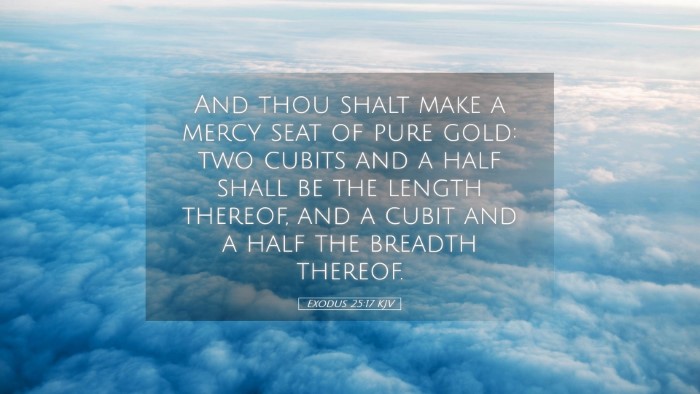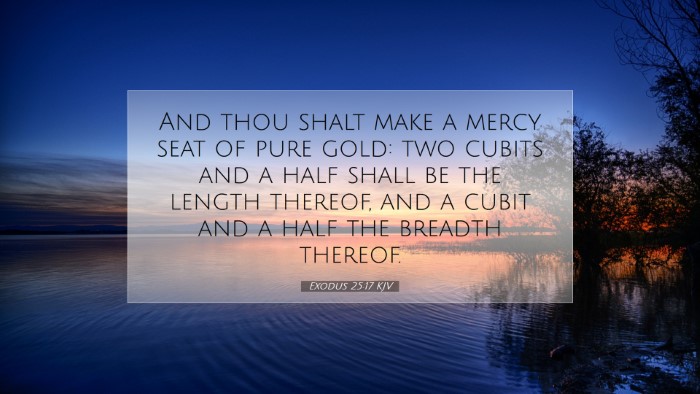Commentary on Exodus 25:17
Verse Exegesis: Exodus 25:17 states, “And you shall make a mercy seat of pure gold; two and a half cubits shall be its length and a cubit and a half its width.” This verse introduces the specific instructions for the construction of the mercy seat, which held immense significance in the worship and sacrificial system of ancient Israel. The details provided serve as essential components in understanding the theological and symbolic implications of this sacred object.
The Significance of the Mercy Seat
The mercy seat, known in Hebrew as "Kapporet," was the lid for the Ark of the Covenant and represented the throne of God among His people. It was where the Divine Presence would manifest, especially during the Day of Atonement when the high priest would sprinkle the blood of the sacrifice upon it. Here are several significant aspects highlighted by notable commentators:
- Matthew Henry: Henry describes the mercy seat as “a type of Christ.” He emphasizes that just as the blood of the atonement was sprinkled upon the mercy seat, so does Christ, our ultimate High Priest, offer His blood for our sins. For Henry, this establishes the mercy seat as not only a literal piece of furniture but a foreshadowing of atonement and reconciliation with God.
- Albert Barnes: Barnes notes the importance of the materials used—specifically, pure gold. He explains that gold signifies divinity and purity, thus underscoring the holiness of God when He meets with His people. This meeting place is sacred and indicates the serious nature of God's presence among the Israelites.
- Adam Clarke: Clarke focuses on the dimensions of the mercy seat. He points out that the measurements (two and a half cubits by one and a half cubits) are symbolic of God’s completeness and glory, showcasing God's desire to dwell with humanity. Clarke also mentions how the mercy seat serves as the locus of divine forgiveness and grace.
Theological Implications
The mercy seat serves multiple theological roles that resonate throughout Scripture:
- Atonement: It symbolizes the atoning work of Christ (Hebrews 9:5). The very name “mercy seat” implies a place of grace, where God meets with His people to dispense mercy and atonement for sin.
- Presence of God: The mercy seat is where God promised to meet Moses and commune with him (Exodus 25:22). This meeting point illustrates God’s desire to dwell among His people, emphasizing the intimacy He seeks with His creation.
- Propitiation: The act of sprinkling the blood on the mercy seat signifies propitiation—a turning away of God's wrath through an acceptable sacrifice (Romans 3:25). This underscores God's justice alongside His mercy.
Historical Context
The construction of the mercy seat took place in a broader context of establishing the tabernacle worship system. This was crucial for the Israelites as they sought to understand their identity as God’s chosen people:
- Covenant Relationship: The instructions for the mercy seat were given within the framework of the covenant God made with Israel at Sinai. It reflects the importance of maintaining a relationship with God that required adherence to His laws and recognition of His holiness.
- National Identity: The mercy seat symbolized God's presence in the midst of His people, defining Israel's national identity. It served as a constant reminder of God's promises and the need for holiness and obedience among His people.
Practical Applications for Today
For contemporary believers, the instructions regarding the mercy seat remind us of several essential truths:
- The Importance of Worship: The mercy seat illustrates the centrality of worship in the life of a believer. Just as the Israelites approached the mercy seat for atonement, Christians are called to approach God through Christ in worship and repentance.
- God's Holiness and Our Need for Atonement: The methodology outlined in Exodus reveals the seriousness with which we should regard sin and our dependence on Jesus as the perfected sacrificial Lamb who takes away sin.
- Intimacy with God: The mercy seat signifies the possibility of communion with God. It encourages believers to pursue a deeper relationship with God through prayer, scripture reading, and dependence on His grace.
Conclusion
Exodus 25:17 serves as a foundational text that encapsulates profound theological principles central to the Christian faith. The mercy seat is not merely an artifact of the Old Testament; it points to the heart of God's redemptive plan through Christ. Understanding its significance enhances one’s comprehension of God's holiness, the meaning of atonement, and the relationship He desires to have with all believers. Through the insights of Matthew Henry, Albert Barnes, and Adam Clarke, we are reminded of the timeless nature of God’s Word and its relevance across ages.


